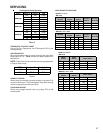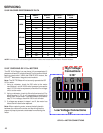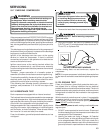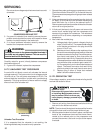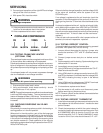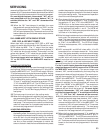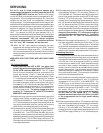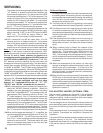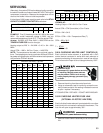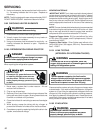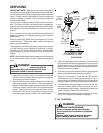
SERVICING
54
4.5 When the first stage heat demand “Y” is satisfied, the
room thermostat will remove the 24Vac from “G” and “Y”.
The heat pump is turned off and the blower motor turns
off after a 65 second off delay.
5.0 Defrost Operation
On heat pump units, when the room thermostat is set to the
heating mode, the reversing valve is not energized. As long
as the thermostat is set for heating, the reversing valve will be
in the de-energized position for heating except during a
defrost cycle.
5.1 The heat pump will be on and operating in the heating
mode as described the Heating Operation in section 4.
5.2 The defrost control in the heat pump unit checks to see
if a defrost is needed every 30, 60 or 90 minutes of heat
pump operation depending on the selectable setting by
monitoring the state of the defrost thermostat attached
to the outdoor coil.
5.3 If the temperature of the outdoor coil is low enough to
cause the defrost thermostat to be closed when the
defrost board checks it, the board will initiate a defrost
cycle.
5.4 When a defrost cycle is initiated, the contacts of the
HVDR relay on the defrost board open and turns off the
outdoor fan. The contacts of the LVDR relay on the
defrost board closes and supplies 24Vac to “O” and
“W2”. The reversing valve is energized and the contacts
on HR1 close and turns on the electric heater(s). The unit
will continue to run in this mode until the defrost cycle is
completed.
5.5 When the temperature of the outdoor coil rises high
enough to causes the defrost thermostat to open, the
defrost cycle will be terminated. If at the end of the
programmed 10 minute override time the defrost thermo-
stat is still closed, the defrost board will automatically
terminate the defrost cycle.
5.6 When the defrost cycle is terminated, the contacts of the
HVDR relay will close to start the outdoor fan and the
contacts of the LVDR relay will open and turn off the
reversing valve and electric heater(s). The unit will now
be back in a normal heating mode with a heat pump
demand for heating as described in the Heating Opera-
tion in section 4.
S-41 MBE/AEPF WITH GSX, SSX, ASX, DSX
MBE ELECTRONIC BLOWER TIME DELAY RELAY
AEPF AIR HANDLER
SEQUENCE OF OPERATION
This document covers the basic sequence of operation for a
typical application with a mercury bulb thermostat. When a
digital/electronic thermostat is used, the on/off staging of the
auxiliary heat will vary. Refer to the installation instruc-
tions and wiring diagrams provided with the MBE/AEPF
for specific wiring connections, dip switch settings and
system configuration.
MBE/AEPF WITH SINGLE STAGE GSX, ASX AND SSX
CONDENSERS
When used with a single stage GSX, SSX and ASX condens-
ers, dip switch #4 must be set to the on position on the VSTB
inside the MBE/AEPF. The “Y” output from the indoor
thermostat must be connected to the yellow wire labeled “Y/
Y2” inside the wire bundle marked “Thermostat” and the
yellow wire labeled “Y/Y2” inside the wire bundle marked
“Outdoor Unit” must be connected to “Y” at the condenser.
The orange jumper wire from terminal “Y1” to terminal
“O” on the VSTB inside the MBE/AEPF must remain
connected.
1.0 Cooling Operation
1.1 On a demand for cooling, the room thermostat energizes
“G” and “Y” and 24Vac is supplied to “G” and “Y/Y2” of the
MBE/AEPF unit. The VSTB inside the MBE/AEPF will
turn on the blower motor and the motor will ramp up to the
speed programmed in the motor based on the settings for
dip switch 5 and 6. The VSTB will supply 24Vac to “Y” at
the condenser and the compressor and condenser are
turned on.
1.2 When the cooling demand is satisfied, the room thermo-
stat removes the 24Vac from “G” and “Y”. The MBE/AEPF
removes the 24Vac from “Y’ at the condenser and the
compressor and condenser fan are turned off. The blower
motor will ramp down to a complete stop based on the
time and rate programmed in the motor.
2.0 Heating Operation
2.1 On a demand for heat, the room thermostat energizes
“W1” and 24Vac is supplied to terminal “E/W1” of the
VSTB inside the MBE/AEPF unit. The VSTB will turn on
the blower motor and the motor will ramp up to the speed
programmed in the motor based on the settings for dip
switch 1 and 2. The VSTB will supply 24Vac to heat
sequencer HR1 on the electric heater assembly.
2.2 HR1 contacts M1 and M2 will close within 10 to 20
seconds and turn on heater element #1. At the same
time, if the heater assembly contains a second heater
element, HR1 will contain a second set of contacts, M3
and M4, which will close and turn on heater element #2.
Note: If more than two heater elements are on the heater
assembly, it will contain a second heat sequencer, HR2,
which will control the 3
rd
and 4
th
heater elements if available.
For the 3
rd
and 4
th
heater elements to operate on a
second stage heat demand, the PJ4 jumper on the VSTB
inside the MBE/AEPF must be cut. With the PJ4 jumper
cut, the VSTB will run the blower motor on low speed on a
“W1” only demand. If the first stage heat demand, “W1”
cannot be satisfied by the heat pump, the temperature
indoors will continue to drop. The room thermostat will then
energize “W2” and 24Vac will be supplied to HR2 on the
heater assembly and the blower motor will change to high
speed. When the “W2” demand is satisfied, the room
thermostat will remove the 24Vac from “W2” and the VSTB will




